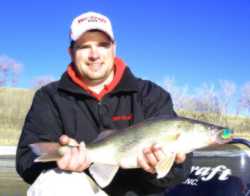| The idea that walleye may indeed follow a lure
for a significant distance before striking surprises many anglers.
Many anglers have this mental picture that fish just lash out
and strike a lure as the lure appears, like an ambush. While
there is no doubt that plenty of ambushing is going on under
water, walleyes in particular will often follow a lure for a
surprisingly long time before striking.
 |
There are situations where walleye have
a tendency to follow or lurk behind the lure with what
seems like a nonchalant attitude where they could just
as well take the bait or leave it. We have watched schools
of fish follow a crank bait for thirty yards or more,
shadowing the bait nipping at the heals until something
tweaks the restraint of one of the fish. Usually, this
trigger might be a stop or pump to the lure to cause something
irregular or perhaps the lure bounces off a rock |
Some slight trigger might be all that is needed to turn followers
into takers. This may explain some of the effectiveness with
planer boards while trolling. The board may give the lure
just a little bit more action; more starts and stops than
a rod hanging out of a rod holder. Because of this tendency
for fish to snap on something irregular like a sudden stop
or stall in the bait or a change in speed, many of the best
trollers are always holding at least one rod, giving the lure
more action.
This challenge to turn followers into takers can indeed be
a challenge at any time of the year. Cold fronts or weather
changes can just put the fish into a mood where they aren’t
lashing out at baits. Fishing pressure can also crop down
the intensity of a bite. From our experience however, this
following tendency is most apparent in the spring when the
water is cool and many of the fish are shallow. Anglers who
can consistently convert a high percentage of following fish
into fish that chomp are going to catch many more fish come
spring.
People often assume that shallow fish are fish that are eating.
Yes, but there is much more to shallow fish than just finding
something to eat. Early in the season, these fish may get
active once a day, late afternoon or early evening after the
sun warms the water a few degrees. The bite becomes a guessing
game of timing. Hit a good spot too early and not see a fish,
hit the same spot an hour later after the water temperature
jumps a few degrees and the fish are on the bite. When the
fish are really on the bite, the reality is that it doesn’t
really matter how you go about your day, you are going to
probably catch a few fish.
The key to really catching fish is figuring out ways to turn
fish when they aren’t really on. What we have found
is that we can catch many more of these turned off fish by
making longer casts. Back the boat off the spot and make longer
casts. I dare say that a longer cast catches three times as
many fish as a short cast when the fish are in a funk and
aren’t snapping. What is a long cast? I would say the
distance of a basket ball court. Longer casts catch many more
fish early in the season or whenever fish are turned off and
the reason is simple. When the fish aren’t snapping
at the baits, you are generally dealing with a bunch of followers.
Fish that just want to follow your crankbait or jig. Longer
casts give these fish more time to eat before you run out
of room at the boat. Often, the change of direction as a lure
begins to rise towards the rod tip is a very powerful trigger
so be ready as you finish your retrieve. A few stalls or pops
as the lure raises towards the boat often snaps the restraint
of following fish for us. So don’t reel the lure all
the way to the rod tip.
To back the boat off the spot and fish the area effectively
by casting, you need to use baits that will cast well. On
Devils Lake the past few years, one of our better baits that
cast well is a Salmo 8F Perch. We have caught a lot of big
walleye on this bait. Other classics include the Countdown
Rapala, Husky Jerks, Rattling Rogues, jigs with Powerbait
and swim baits. Lighter line can also aid with casting as
does a longer rod. Depending on your height and arm length,
a seven or seven foot medium light action rod is great for
getting that whipping action necessary to launch baits into
the upper deck. We have designed a couple of rods that excel
for pitching crankbaits and jigs into still water. These rods
are the Jason Mitchell Elite Series JMSS70MLX and the JMSS76MLXF.
We built these rods out of a hard to find graphite that is
of superior quality which makes the rod unusually light to
hold and helps with the fatigue of fishing all day.
When walleye fishing this spring, be aware of the fact that
turned off fish don’t lash out at baits or ambush but
follow and nip. When you encounter situations that turn down
active fish, back off and be conscience of what is happening
under water with how fish are attacking your lure or bait.
These slight adjustments can often help you catch fish before
or after the prime window of opportunity is over.
Editors Note: the author Jason Mitchell is a legendary guide
on North Dakota’s Devils Lake and designer of a lineup
of high quality walleye fishing rods called the Jason Mitchell
Elite Series Rods, www.jasonmitchellrods.com.
|

